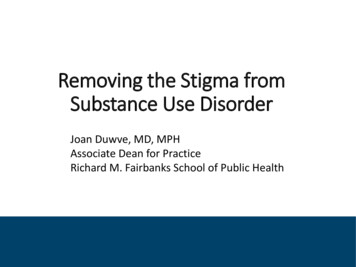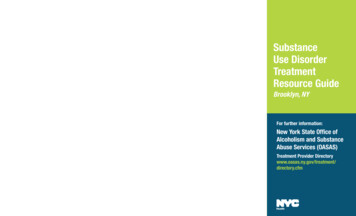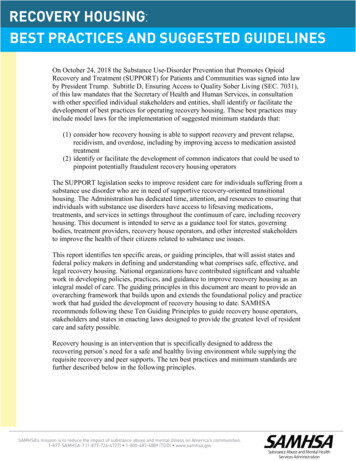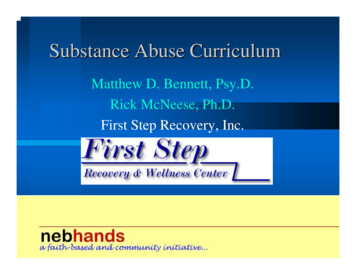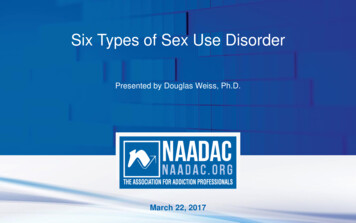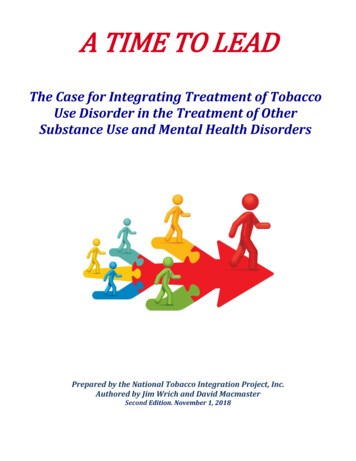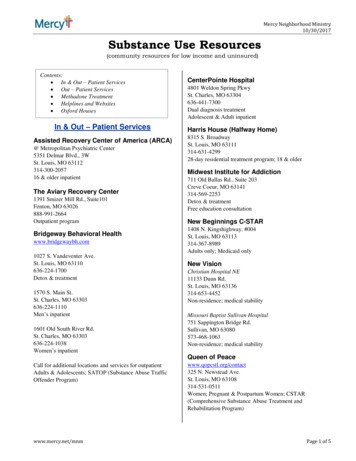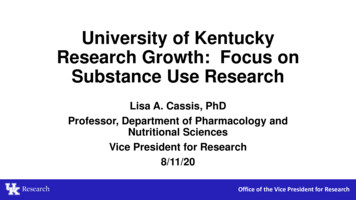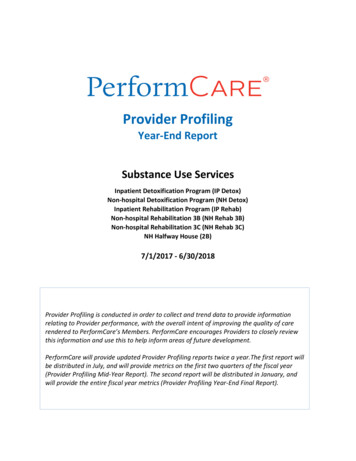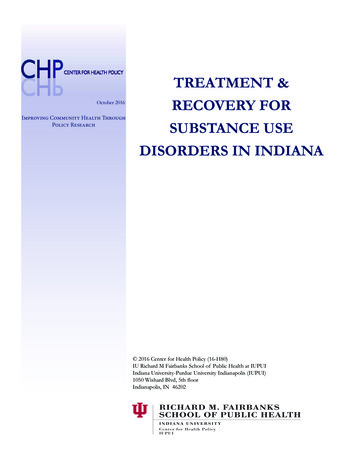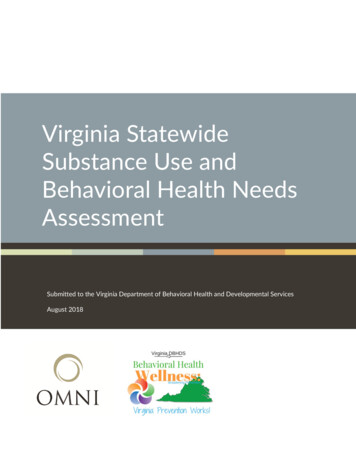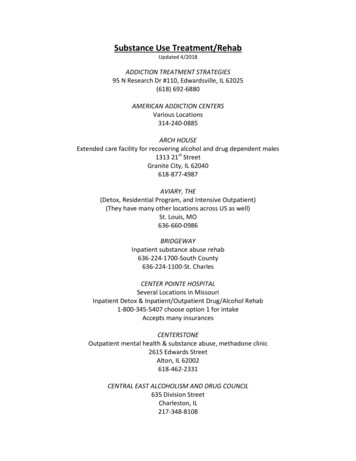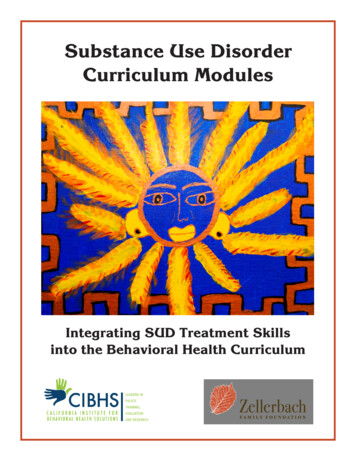
Transcription
Substance Use DisorderCurriculum ModulesIntegrating SUD Treatment Skillsinto the Behavioral Health Curriculum
Substance Use Disorder Curriculum ModulesIntegrating SUD Treatment Skillsinto the Behavioral Health Curriculum
Substance Use Disorder Curriculum ModulesIntegrating SUD Treatment Skillsinto the Behavioral Health CurriculumThese modules were compiled by Kristin Dempsey, LMFT, LPCC, Senior Associate, CaliforniaInstitute for Behavioral Health Solutions, and Robert Williams, Ph.D., Associate Professor ofCounseling in the College of Health and Social Sciences, San Francisco State University.Development of these SUD Curriculum Modules was made possible by funding from theZellerbach Family Foundation in collaboration with the Greater Bay Area Mental Health andEducation Workforce Collaborative.Front cover artwork: Rosalia Paredes, MHSA, Department of Behavioral Health, Fresno CountyFor questions or feedback about the modules:please contact Kristin Dempsey at kdempsey@cibhs.orgCalifornia Institute for Behavioral Health Solutions2125 19th Street, 2nd FloorSacramento, CA 95818(916) 556-3480www.cibhs.orgSUD ModulesPage ii
Table of contentsWhy the Substance Use Disorder (SUD) Curriculum Modules were created. ivModule 1: Culture of Addiction .1Module 2: Engaging the SUD Client.9Module 3: The Intersection of Multiculturalism and SUDs.17Module 4: Case Management .29Module 5: Co-Occurring Mental Health and Substance Use Disorders .37Module 6: Relapse Prevention .53Module 7: Family and Community.61Module 8: Adolescents, Young Adults.69Module 9: Co-Occurring Substance Use and Primary Care.77SUD ModulesPage iii
PREFACEWhy the Substance Use Disorder (SUD)Curriculum Modules were createdAbout 7.9 million individuals in the United States reported a co-occurring mental health andsubstance use disorder in 2014 (SAMHSA, 2017). In a report published in 2012, the NationalCenter on Addiction and Substance Abuse estimated that 40 million Americans can bediagnosed with “the disease of addiction,” and an additional 80.4 million individuals are usingsubstances in a manner that threatens their health and safety. Such statistics indicate that abouta third of Americans are significantly impacted by substance use disorders, yet our behavioralhealth workforce is typically not receiving sufficient training on substances use, addiction, orrelated disorders.Depending on the discipline and the regulatory requirements associated with various degreeprograms, substance use treatment training can range from daylong workshops to fifteen-weekcourses. The quality of substance abuse treatment curricula can be of high quality, but given theprevalence of the associated disorders, trainees are often left in need of more skills and/orpractice with SUD issues when they enter the workforce.Creation of the SUD Curriculum Modules is an attempt to expand the SUD clinicaltreatment into other areas of clinical training so future providers can benefit fromlearning how to address SUD in various contexts. The topics in this manual have beendetermined by focus group and survey research involving SUD consumers and familymembers, college and university faculty members, and mental health and substanceuse treatment providers in the San Francisco Bay Area.The modules are intended to be used in non-substance use disorder courses, so theSUD treatment components can be more broadly distributed throughout the trainingcurriculum. Each topic area includes student learning objectives, questions for a preand post-test, and lecture, discussion and/or teaching exercises ranging from one hourto three hours in duration. The goal is to provide behavioral health faculty with SUDtraining material that can be used flexibly within the classroom or training setting.SUD ModulesPage iv
Sample Grid for Determining Where to Use SUDs Modules in CurriculumModules can be used in any course. This grid is to help determine some sample matching ofmodules to curriculum and is to be considered a potential tool for course M6M7!!!!!!!Marriage and Family!Field InstructionPracticum!Psychological Testing!Psychopharmacology/Geriatric PharmacologyM9!DevelopmentalLaw and EthicsM8!!Human Behavior andSocial icro – Children, Youthand Families!!!!!!!!!!!!!!!!!Micro – CommunityMental Health!!!!!!Psycho Social Rehab!!!!!!!!!!!!!!!!Key to modules:M1: Culture of AddictionM6: Relapse PreventionM2: Engaging SUD ClientsM7: Family and CommunityM3: Intersection of Multiculturalism and SUDsM8: Adolescents, Young AdultsM4: Case ManagementM9: SUD and Primary CareM5: Co-Occurring Mental Health and SUDSUD ModulesPage v
SUD ModulesPage vi
MODULE 1Culture of AddictionSubstance use as its own culture. Work with stigma as it shows up in addiction.Where does it belong: Cultural competency Community mental health Macro concepts (social work)
Student Learning ObjectivesAs a result of this module, students will achieve the following outcomes:1. Reduction of stigma around addiction and addiction-related disorders that could impactclinician judgment and reduce accuracy of assessment, treatment planning, andintervention.2. Reduction of stigma around addiction through increased empathy and compassion inorder to build therapeutic alliance and allow of more accurate SUD assessment, planning,and intervention.Module 1: Culture of AddictionSubstance Use Disorder Curriculum Modules: Page 2
Module 1, Pre- and Post-TestPart 11. When an issue such as substance use is stigmatized, those who are engaged in thebehavior can feel (disgraced, shame, embarrassed. Other negativeemotional responses are accepted).2. In the field, it is not uncommon to call a positive drug screen “dirty.” T/F (True.)3. Stigma around substance use treatment is a major reason individuals might avoidseeking help. T/F (True.)4. The language we use when working with people with substance use disorders has noimpact on perceived or actual stigma. T/F (False.)Part 25. People in recovery do not have their own distinct culture. T/F (False.)6. One belief that increases stigma toward substance users is that substance users are at“fault” for their disorder. T/F (True.)7. A counselor’s countertransference can contribute to stigma toward substance users. T/F(True.)8. As substance use issues are an individual’s responsibility, someone with a substanceuse disorder (SUD) will probably not benefit in any significant way from spending timewith other people with SUD. T/F (False.)Module 1: Culture of AddictionSubstance Use Disorder Curriculum Modules: Page 3
Module 1, Part 1Summarize the reading "Addiction Language" PDF.Pre-lecture Exercise1. Draw a line across the board.2. Left side — Have students word-associate what comes to mind when you bring up theword "heart disease." Write exactly what they say. Edit or change what is said only inresponse to clarification.3. Right side — Have students brainstorm what comes to mind when they hear the word"addiction."Lecture1. Review differences between primary care test results and SUD results — "Elevatedglucose levels" vs. "Dirty" test. Among 23 million Americans who meet criteria for a substance use disorder eachyear, only 10% access treatment, and stigma is a major barrier to seeking help.2. Two main factors influence stigma: cause (it is their FAULT) and controllability (canCONTROL addiction).3. Chronic effects of substances on the central nervous system produce profound changesin brain structure and function that radically impair efforts to control use, despite harmfulconsequences. Yet, despite evidence of a strong causal role for genetics andimpairment in inhibitory control, stigma is alive and well. Research is now revealing thatone contributory factor to the perpetuation of stigma may be the type of language weuse.4. Have students review their list and notice the different comparisons between what theycreated on the lists. How might our immediate reactions impact how we feel about aclient? How might it shape our interactions?Exercise1. Give half of the group the first vignette on the second page of the addiction languagearticle (see below). Give the other half the second vignette. Have each group discusstheir immediate perceptions and concerns about the case and where they might start.2. Have the groups come together, ask them to read the two vignettes side by side, andcompare the thought process of each group. Review their conclusions on how languagecan impact the case formulation and treatment planning.Module 1: Culture of AddictionSubstance Use Disorder Curriculum Modules: Page 4
Lecture1. Use of the more medically and scientifically accurate “substance use disorder”terminology is linked to a public health approach that captures the medical malfunctioninherent in addiction. Use of this term may decrease stigma and increase help-seeking.2. In contrast, tough, punitive, language, including the word “war,” as in “war on drugs,” isintended to send an uncompromising message, “You use, you lose,” in the hopes ofdeterring drug involvement. Accompanying this aggressive rhetoric are terms such asdrug “abuse” and drug “abusers,” implying willful misconduct (i.e., “they can help it and itis their fault”). This language increases stigma and reduces help seeking.Addiction language article: 0/pdfReferenceKelly, J.F., Wakeman, S.E., & Saitz, R. (2015). Stop talking ‘dirty’: Clinicians, language,and quality of care for the leading cause of preventable death in the UnitedStates. American Journal of Medicine, 128(1), 8–9. Retrieved Module 1: Culture of AddictionSubstance Use Disorder Curriculum Modules: Page 5
Module 1, Part 2Introduce the students to Faces & Voices of Recovery.LectureFaces & Voices of Recovery is dedicated to organizing and mobilizing the over 23 millionAmericans in recovery from addiction to alcohol and other drugs, our families, friends, and alliesinto recovery community organizations and networks. The organization promotes the right andresources to recover through advocacy, education, and demonstrating the power and proof oflong-term recovery.Visit: http://www.facesandvoicesofrecovery.orgDiscuss Why do people with SUD need to have an advocacy organization? How might linking a client to an advocacy organization impact treatment?DISCUSSION RE: Faces and Voices of Recovery Policy Position Paper #1Download: Faces & Voices of Recovery Policy Position Paper #1 In what ways does the Policy Position Paper #1 (PPP 1) positioning paper challenge thecultural norms for addiction? How does the PPP 1 positioning paper challenge some of your own thoughts aboutaddiction? Given the PPP 1how do you think you might change how you intervene with someonewith a substance use disorder? Would your intervention be different for someone who has been "mandated" (ordered) totreatment? Why or why not? Would your intervention be different for a family member?Why or why not?Exercise Have students choose or assign video vignettes from this o/recovery-stories.htmlIn a small group, consider how you might approach a person in treatment who is coming to youat the time they are in greatest need: What are the main concerns you think this person would want to address?Module 1: Culture of AddictionSubstance Use Disorder Curriculum Modules: Page 6
How might you start the conversation about their SUD? Are there any values or attitudes that would come up for you as a result of hearing theirstory? How might you manage the counter-transference? If you don't identify any of yourown concerns, what concerns might an individual have? What might be one intervention you could use to help affirm or empower the client? Howwould this help the client to engage in his or her own treatment?ReferencesRecovery community organizations: Discrimination Policy Position Paper #1. (Retrievedon 9 March 2017 from:https://www.google.com/url?sa t&rct j&q &esrc s&source web&cd 1&cad rja&uact 8&ved 0ahUKEwjkl67lgMrSAhVFKiYKHY52CjQQFggaMAA&url http%3A%2F%2Ffacesandvoicesofrecovery.org%2Ffile download%2F07eff536-1f704fb7-8682f3021f231aef&usg AFQjCNFEnxT8Z6lqGO7QouUb6Jw isU7eA&sig2 rXs-wh nALTr5tDgJk15w&bvm bv.149093890,d.eWEFaces & Voices of Recovery: Recovery stories. (Retrieved on 27 February 2017 o/recovery-stories.htmlAll links were live at time of publication (March 2017). However, links can become nonfunctional. If a link for Faces and Voices of Recovery is no longer operable, please search for"Faces and Voices of Recovery” to find current resources with similar content.Module 1: Culture of AddictionSubstance Use Disorder Curriculum Modules: Page 7
Module 1: Culture of AddictionSubstance Use Disorder Curriculum Modules: Page 8
MODULE 2Engaging the SUD ClientEngaging substance-using clients into therapy is the most critical stage oftreatment. The majority of substance-using clients drop out of treatment before orafter the first session. This points to the importance of engaging the client fromthe very first point of contact. To be successful, clinicians need to understand (a)stages of change and how to quickly assess stages of change, (b) motivationalinterviewing and how it can be used to engage a client into treatment, and (c)how to use family dynamics in support of engaging the substance-using clientinto treatment.
Student Learning ObjectivesAs a result of this module, students will achieve the following outcomes:1. Recognize the underlying premises of motivational interviewing and how these conceptsrelate to engaging clients in treatment.2. State the targeted interaction skills associated with motivational interviewing.3. Summarize the transtheoretical model on stages of change, and apply this model tocurrent counseling cases.4. Analyze when a client is in or out of sync with therapy, and guide disengaged clients inrestoring synchronization.Module 2: EngagementSubstance Use Disorder Curriculum Modules: Page 10
Module 2 Pre- and Post-TestPart 11. A counselor can expect that a client with substance use issues will be resistant. T/F(False — our interactions create resistance.)2. Empathic responses help engage people in treatment, and reduce resistance. T/F(True.)3. There is nothing a counselor can do to engage a student if he or she was mandated toattend sessions. T/F (False.)4. What skill does each letter stand for in the AROSE interaction skills module?A:R:O:S:E:Part 21. What are the six stages of change, according to the transtheoretical model of change?(precontempation, contemplation, planning, action, maintenance, relapse/recycle)2. A client who was referred to you by her probation officer says that although she wastold to see you, she doesn’t believe she needs help because she “doesn’t have aproblem.” What stage of change might you consider for her?3. You have seen John for six months. He drinks beer and occasionally hard liquor fourtimes a week. He comes to you reporting that he is still using, but he wants to startattending 12 Step meetings because he thinks doing so eventually will help him tostop. Given just this information, what stage of change would you assign to John?4. Rebecca had chosen quitting smoking as a target behavior. Eight months ago she quitsmoking, and she has remained completely smoke-free. She does spend time tryingto avoid smoking triggers, such as spending long evenings in bars, and she hasstarted some light exercise to help her manage stress. What stage of change mightyou consider for Rebecca?Module 2: EngagementSubstance Use Disorder Curriculum Modules: Page 11
Module 2, Part 1Lecture 1 and Activities1 hourIt may be ideal to begin the lecture with an exercise in which the instructor plays the role of aclient who needs to be "motivated" to do something (e.g., eat differently, go to the gym,complete homework assignments). Ask students, one at a time, to offer their counseling skills to"help you" change your behavior. While listening to their counseling interventions, work at twolevels: (a) respond in a manner that is consistent with the particular intervention, and (b) makeinternal notes about interventions that seem to be more consistent with engagement. At the endof the exercise, point out which interventions seemed consistent with empathic engagement.The AROSE skills can be used to engage clients who are new to treatment and/or ambivalentabout changing their behavior or behaviors (Miller and Rollnick, 2013):A – AffirmationR – ReflectionO – Open-ended questionsS – SummariesE – Elicit needs, provide advice or information, elicit feedbackLecture on empathic engagement. Individuals with SUD are not resistant. Resistance is createdwhen the clinician pushes an agenda that is not the client’s.Also consult www.motivationalinterviewing.orgQuestions to Consider:We consider the metaphor of "dancing vs. wrestling" in motivational interviewing. What do youthink is the meaning of this metaphor in terms of client engagement? When we are out of sync,it feels as if we are wrestling with a client. When we are moving along in-sync, engaging themwhere they are in the change process, and using the AROSE skills — with mostly reflection —we tend to "dance" or move the client along. What types of responses moved the instructor toward change talk? What responses tend be less engaging, and engender more resistance?Other situations to consider: Asking too many questions in a row, especially closed or non-evocative questions Unwanted or poorly timed advice Too much information (overwhelming the client) Insisting on “taking responsibility” for the presenting problem.Module 2: EngagementSubstance Use Disorder Curriculum Modules: Page 12
Module 2, Part 2Lecture 21.5 hoursLecture on “stages of change,” emphasizing that change is related to one particularbehavior rather than an entire group of behaviors. Using page 70 at the default/files/mia-step.pdf, review thestages of change. Help the students consider how the stage of change mightinfluence how, where and when a clinician engages. End this discussion emphasizingthat we start where the client is willing to start (the “action stage”), and approach theplaces of "pre-change" with empathy, curiosity and respect.ActivityYou are someone who has a diagnosis or schizoaffective disorder, bipolar type and alcoholuse disorder. Moderate. How might you be engaged if you were in ACTION regarding your mentalhealth concern and in pre-action regarding your alcohol use? How might the clinician engage differently if someone were in ACTION regarding hersubstance use and pre-action regarding the mental health issue?Next step: consider assigning the students to take on one of the above positions.Have students practice engaging each other using AROSE skills. Do this in triads,with one student observing the "counseling." The observer should actively take notesand provide feedback at the end of the session, describing which interventions workand what could be changed.Module 2: EngagementSubstance Use Disorder Curriculum Modules: Page 13
Family-Level Manifestations of Stages of Change
Work with stigma as it shows up in addiction. Where does it belong: Cultural competency Community mental health Macro concepts (social work) Module 1: Culture of Addiction Substance Use Disorder Curriculum Modules: Page 2 Student Learning Objectives As a result of this mod
